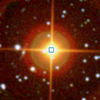CXC Home | Search | Help | Image Use Policy | Latest Images | Privacy | Accessibility | Glossary | Q&A
Tour of CH Cyg
Quicktime MPEG
Deep within this optical image lies an intriguing system known as CH Cyg. CH Cyg is a binary star system containing a white dwarf that feeds from the wind of a red giant star. The material from the wind forms a hot accretion disk around the white dwarf before crashing onto the star. CH Cyg is one of only a few hundred so-called symbiotic systems known, and one of the closest to Earth at a distance of only about 800 light years. By combining X-ray data from Chandra, optical data from Hubble, and radio data from the Very Large Array, scientists can study CH Cyg like never before. This image shows material in a jet, moving with a speed of over three million miles per hour, powered by material spinning into the accretion disk around the white dwarf. Systems like CH Cyg are fascinating objects because the components are codependent and influence each other's structure, daily life, and evolution.
[Runtime: 01:03]
Quicktime MPEG
Deep within this optical image lies an intriguing system known as CH Cyg. CH Cyg is a binary star system containing a white dwarf that feeds from the wind of a red giant star. The material from the wind forms a hot accretion disk around the white dwarf before crashing onto the star. CH Cyg is one of only a few hundred so-called symbiotic systems known, and one of the closest to Earth at a distance of only about 800 light years. By combining X-ray data from Chandra, optical data from Hubble, and radio data from the Very Large Array, scientists can study CH Cyg like never before. This image shows material in a jet, moving with a speed of over three million miles per hour, powered by material spinning into the accretion disk around the white dwarf. Systems like CH Cyg are fascinating objects because the components are codependent and influence each other's structure, daily life, and evolution.
[Runtime: 01:03]
(Credit: X-ray: NASA/CXC/SAO/M.Karovska et al; Optical: NASA/STScI; Radio: NRAO/VLA]; Wide field [Optical (DSS))
Return to CH Cyg (June 09, 2010)



